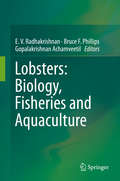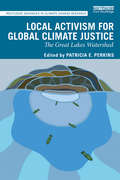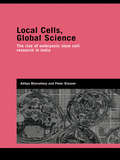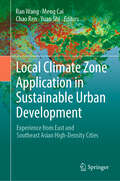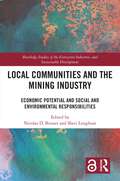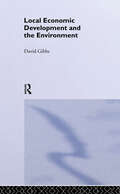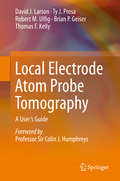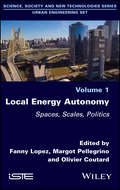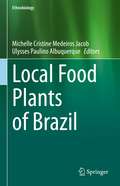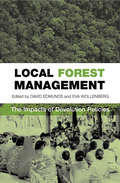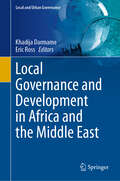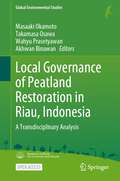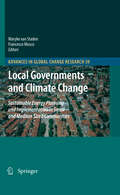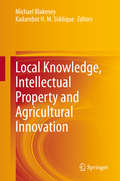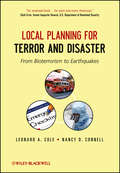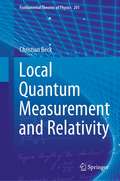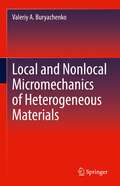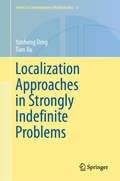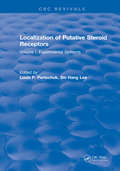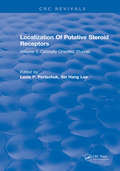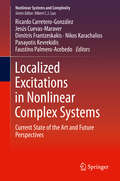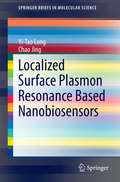- Table View
- List View
Lobsters: Biology, Fisheries and Aquaculture
by Bruce F. Phillips E. V. Radhakrishnan Gopalakrishnan AchamveetilThis book is an important addition to the knowledge of lobster research. The book complements other books published on lobster research and management as it focuses on Indian lobster fisheries and aquaculture developments where there have been nearly 350 research papers and reports and 19 PhD awards. The book has 15 chapters written by international experts covering many aspects of the biology of a number of spiny and slipper lobster species occurring in India and world oceans with maps illustrating global distribution of spiny lobster families, genera and species. An updated taxonomy and checklist of marine lobsters, the status and management of lobster fisheries in India and Indian Ocean Rim countries and a review of aquaculture research in India and other major countries have also been presented. The book is timely as the 2nd International Indian Ocean Expedition (IIOE) is currently underway (2015-2020), 50 years after the original IIOE (1959-1965), with some of the original lobster research on the biology and distribution of phyllosoma larvae being undertaken on the plankton samples collected during the first IIOE. Many of the chapters are contributed by the authors from Central Marine Fisheries Research Institute (CMFRI), which has been collecting fishery and biological data on lobsters since 1950 when lobster fishing began on a subsistence scale, followed by some industrial fishing for lobsters in different parts of India. Unfortunately, the development of some of these lobster fisheries was followed by overfishing due to lack of enforcement of regulations. The book provides a valuable addition to our knowledge of the biology, fisheries and aquaculture of spiny and slipper lobsters.
Local Activism for Global Climate Justice: The Great Lakes Watershed (Routledge Advances in Climate Change Research)
by Patricia E. PerkinsThis book will inspire and spark grassroots action to address the inequitable impacts of climate change, by showing how this can be tackled and the many benefits of doing so. With contributions from climate activists and engaged young authors, this volume explores the many ways in which people are proactively working to advance climate justice. The book pays special attention to Canada and the Great Lakes watershed, showing how the effects of climate change span local, regional, and global scales through the impact of extreme weather events such as floods and droughts, with related economic and social effects that cross political jurisdictions. Examining examples of local-level activism that include organizing for climate-resilient and equitable communities, the dynamic leadership of Indigenous peoples (especially women) for water and land protection, and diaspora networking, Local Activism for Global Climate Justice also provides theoretical perspectives on how individual action relates to broader social and political processes. Showcasing a diverse range of inspirational and thought-provoking case studies, this book will be of great interest to students and scholars of climate justice, climate change policy, climate ethics, and global environmental governance, as well as teachers and climate activists.
Local Cells, Global Science: The Rise of Embryonic Stem Cell Research in India (Genetics and Society)
by Aditya Bharadwaj Peter GlasnerOne of the first studies of an exciting new development in global biotechnology, this cutting edge text examines the extent of the transnational movements of tissues, stem cells, and expertise, in the developing governance framework of India. Documenting the impact of local and global governance frames on the everyday conduct of research, this groundbreaking book traces the journey of ‘spare’ human embryos in IVF clinics to public and private laboratories engaged in isolating stem cells for potential therapeutic application. The discussion also examines the gender dimension as a potential site for exploitation in the sourcing of embryonic and other biogenic materials, and suggests that a moral economy has developed in which the ethical values of the global 'North' support and encourage the donation of abundant and ethically ‘neutral’ embryos by the 'South'. This unique exploration is grounded in an empirical, multi-sited ethnographic study that takes a thoroughly comparative analysis of the ethical, religious and social issues in Europe, the United States, and organ donations already prevalent in India. In this theoretically-sensitive analysis, the authors use the resources of social anthropology and the social sciences in an innovative text which will appeal to postgraduates and professionals in the areas of STS studies, genetics, bioethics, and anthropology.
Local Climate Zone Application in Sustainable Urban Development: Experience from East and Southeast Asian High-Density Cities
by Ran Wang Chao Ren Meng Cai Yuan ShiThe study of local climate zones (LCZ) links urban morphology, land use and land cover types, human activity, and thermal properties, and provides a standard framework for studying urban climatic issues. In recent years, the LCZ scheme attracts more and more attention from climatologists, urban planners, environmental engineers, as well as architects due to its combination of urban climatic scientific research outputs and urban planning and morphology language. Urbanization and higher-density living, an ongoing and continued path of human development, brings various urban climatic and environmental problems. Urban development in a sustainable way is vital for high-density cities to build a comfortable living environment.This book is the first one presenting systematically the latest LCZ applications by taking Asian high-density cities as an example. Generally, four parts are introduced and discussed in this book. At first, a general background of urbanization and its impacts is introduced, and the basic knowledge of LCZ. The second part introduces the methodology and techniques of LCZ data development. In the third part, various applications of LCZ are demonstrated in practice, including application to urban heat island, land use and land cover analysis, wind environment, energy consumption, thermal comfort studies and so on. Lastly, this book concludes the progress, challenges, limitations, and future work of LCZ-related studies.The book will be of interest to all that are working on or interested in urban climate, sustainable urban development, and policy-making.
Local Communities and the Mining Industry: Economic Potential and Social and Environmental Responsibilities (Routledge Studies of the Extractive Industries and Sustainable Development)
by Nicolas D. Brunet Sheri LongboatThis book explores the challenges and opportunities at the intersection of the global mining sector and local communities by focusing on a number of international cases drawn from various locations in Canada, the Philippines, and Scandinavia. Mining’s contribution to economic development varies greatly across countries. In some, it has been a major engine of development, but in others, disputes have erupted over land use, property rights, environmental damage, and revenue sharing. Corporate social responsibility programs are increasingly relied upon to manage company-community relations, yet conflicts persist in many settings, with significant costs for companies and communities. Exploring the many factors and drivers that characterize relationships among different actors within the sector, the volume contributes towards the development of practical wisdom, collective understanding, common sense, and prudence required for the mining sector and community partners to realize the economic potential and social and environmental responsibilities of non-renewable resource development. The book examines case studies from Canada, Scandinavia, and the Philippines, three regions amongst the world's top countries of mining operations. Drawing on their extensive experience in these regions, the contributors explore distinctive mining sectors in the Global North and South, the variation surrounding different types of extractive industries, and at different scales, and the legal processes in place to protect local communities. Key themes include corporate social responsibility, impact assessment, foreign ownership, Indigenous Peoples, gender, local insurgency, and mining disasters as well as climate change. The book identifies areas of future research and pathways to achieving stronger, respectful, and mutually beneficial relationships at the nexus of global mineral extraction and local communities. This book will be of great interest to students and scholars of the extractive industries, natural resource management, sustainable business and corporate social responsibility, Indigenous studies, and sustainable planning and development.
Local Economic Development and the Environment
by David GibbsThis book focuses upon the potential to integrate economic and environmental policies at the local and regional scale. Local initiatives are investigated within their wider economic and environmental policy contexts in order to illustrate both the constraints and opportunities for local policy makers. Attention is given to global economic trends, as well as to the specific policy contexts of the European Union and the national contexts of the UK, USA, Australia, Japan and Sweden. The key principles for designing integrative policies and descriptions of initiatives and projects in a variety of locations are also considered.
Local Electrode Atom Probe Tomography
by David J. Larson Ty J. Prosa Robert M. Ulfig Brian P. Geiser Thomas F. KellyThis book is the first, single-source guide to successful experiments using the local electrode atom probe (LEAP®) microscope. Coverage is both comprehensive and user friendly, including the fundamentals of preparing specimens for the microscope from a variety of materials, the details of the instrumentation used in data collection, the parameters under which optimal data are collected, the current methods of data reconstruction, and selected methods of data analysis. Tricks of the trade are described that are often learned only through trial and error, allowing users to succeed much more quickly in the challenging areas of specimen preparation and data collection. A closing chapter on applications presents selected, state-of-the-art results using the LEAP microscope.
Local Energy Autonomy: Spaces, Scales, Politics
by Olivier Coutard Fanny Lopez Margot PellegrinoIn Europe, numerous forms of energy self-sufficiency or small technical systems exist, are promoted and discussed. They share the ambition to reduce the dependence to inherited/incumbent large technical systems in various sectors (energy and water supply, sanitation, waste management...) through the implementation of “local” energy systems and “small” grids. The contemporary energy and environmental crisis could rush the end of large technical systems (networks and infrastructures) as they have been developed since the late 19th century. This book examines the various options to transition.
Local Food Plants of Brazil (Ethnobiology)
by Ulysses Paulino Albuquerque Michelle Cristine Medeiros JacobThere has been growing academic interest in local food plants. This is a subject that lies at the frontiers of knowledge of various areas, such as environmental sciences, nutrition, public health, and humanities. To date, however, we do not have a book bringing these multi-disciplinary perspectives to bear on this complex field. This book presents the current state of knowledge on local Brazilian food plants through a multidisciplinary approach, including an overview of food plants in Brazil, as well as comprehensive nutritional data. It compiles basic theories on the interrelationship between biodiversity and food and nutrition security, as well as ethnobotanical knowledge of local Brazilian food plants. Additionally, this title provides various methods of learning and teaching the subject, including through social media, artificial intelligence, and through workshops, among others.
Local Forest Management: The Impacts of Devolution Policies
by David Stuart Edmunds Eva Karoline Wollenberg'A well written book, astutely organized.' Development and Change Local Forest Management is built around careful and illuminating case studies of the effects of devolution policies on the management of forests in several Asian countries. The studies demonstrate that devolution policies - contrary to the claims of governments - actually increased governmental control over the management of local resources and did so at lower cost. The controversial findings show that if local forest users are to exercise genuine control over forest management, they must be better represented in the processes of forming, implementing and evaluating devolution policies. In addition, the guiding principle for policy discussions should be to create sustainable livelihoods for local resource users, especially the poorest among them, rather than reducing the cost of government forest administration. This book is essential reading for forest and other natural resource managers, policy makers, development economists and forestry professionals and researchers.
Local Governance and Development in Africa and the Middle East (Local and Urban Governance)
by Eric Ross Khadija DarmameThis edited volume surveys how current local governance policies and development strategies across Africa and the Middle east are advancing Sustainable Development Goals (SDGs). Morocco's recent experience with local development strategies serves as starting point for the discussion. Over the past decade, Morocco has undertaken a variety of initiatives aimed at reducing poverty and social inequalities and providing essential services to marginalized communities. These initiatives provide great opportunities to reshape the spatial organization of regions, and to address chronic local issues of infrastructure and investment. Local governance is the most direct way of providing basic services to populations, helping to alleviate socio-spatial inequalities. Also, it is and will continue to be the best way to engage people and local governments in economic, social and human development agendas. However, placing local governance at the heart of development strategies requires going well beyond participatory approaches to policy making. Local communities and their governments need to be empowered. As responses to the Covid19 epidemic have laid bare, new and more efficient modes of territorial governance are needed at local and regional levels if current global-scale challenges are to be met. While development and governance strategies like Morocco's are framed by global agreements and standards, there is a need to understand them at the regional scale. Are there discernible patterns in how African and Middle Eastern countries design and implement them? This volume assembles case studies from across the region, allowing for understandings that transcend the usual spatial dichotomies between "North" and "Sub-Saharan" Africa, between Africa and the Middle East, and between the "Anglophone" and "Francophone" spheres. The volume builds upon an international conference on the topic held at Al Akhawayn University in Ifrane, Morocco Morocco in February of 2022. The volume is aimed at a readership of researchers and development practitioners, and will be of most direct benefit to advanced undergraduate and graduate-level students.
Local Governance of Peatland Restoration in Riau, Indonesia: A Transdisciplinary Analysis (Global Environmental Studies)
by Masaaki Okamoto Takamasa Osawa Wahyu Prasetyawan Akhwan BinawanThis open access book is one in a series of four volumes introducing peatland conservation and restoration in Indonesia. It focuses on local governance, in particular on regional and local perspectives in Riau, the most peat-destructed province of Indonesia. The book fills a vital gap in the existing literature that overlooks social science and humanities perspectives. Written by authors from different disciplines and backgrounds (including scholars and NGO activists), the approaches to the topic are various and unique, including analysis of GPS logs, social media, geospatial assessments, online interviews (conducted due to the Covid-19 pandemic), and more conventional questionnaires and surveys of community members. The chapters cover an interdisciplinary understanding of peatland destruction and broadly offer insights into environmental governance. While presenting combined studies of established fieldwork methodologies and contemporary technology such as drones and geospatial information, the book also explores the potential of long-distance research with rural communities through online facilitation, which was brought about by Covid-19, but that may have longterm implications. Readers will gain a comprehensive understanding of the complexities surrounding peatland conservation and restoration and recognize the significance of locally inclusive approaches that use contemporary but accessible technologies to sustainably govern the globally important resource of peatland. That approach would be useful for other environmentally fragile but important regions and give some ideas to achieve the United Nations’ SDGs for 1)No Poverty, 5)Gender Equality, 13)Climate Action, 15)Life of Land.
Local Governments and Climate Change
by Maryke Van Staden Francesco MuscoThe focus of this publication is on how small and medium-sized communities in Europe are effectively responding to climate change, with a particular focus on different approaches used in sustainable energy planning and implementation. A number of cases presented show the result of different (and often combined) motivations and actions. The most effective responses are those with a holistic, integrated and long-term approach, addressing both climate change mitigation and adaptation, based on citizen and other local stakeholder involvement. Local climate action means addressing different sectors, from buildings to waste, but also involving the industry and business sectors. The focus is on engaging communities on a large scale. Local governments play an essential role in this regard: creating a vision for the community, developing relevant strategies, implementing effective policies and rolling out actions - together with other actors. They lead citizens, act in an exemplary manner, and improve energy use in services. The context they act in is also important, influencing approaches taken, with (enabling or blocking) framework conditions, financing, and energy security addressed, as well as a number of important international and European community-specific developments are presented.
Local Group Cosmology
by David Martínez-DelgadoOne of the most fascinating unresolved problems of modern astrophysics is how the galaxies we observe today were formed. The Lambda-Cold Dark Matter paradigm predicts that large spiral galaxies such as the Milky Way formed through accretion and tidal disruption of satellite galaxies. The galaxies of the Local Group provide the best laboratory in which to investigate these galaxy formation processes because they can be studied with sufficiently high resolution to exhume fossils of galactic evolution embedded in the spatial distribution, kinematics, and chemical abundances of their oldest stars. Based on the twentieth Winter School of the Canary Islands Institute of Astrophysics, this volume provides a firm grounding for graduate students and early career researchers working on Local Group cosmology. It presents modules from eight eminent and experienced scientists at the forefront of Local Group research, and includes overviews of observational techniques, diagnostic tools, and various theoretical models.
Local Knowledge, Intellectual Property and Agricultural Innovation
by Michael Blakeney Kadambot H. M. SiddiqueThis book examines the role of local knowledge in promoting agricultural innovation and legislative support for agricultural innovation through intellectual property laws and the protection of farmers’ rights. In assessing the role of intellectual property in promoting agricultural innovation the book examines plant variety rights protection, the patenting of plant varieties and plant breeding methods; gene patents and climate change; open source biotechnology and agricultural innovation and geographical indications and the marketing of agricultural products. As a test bed for the application of the themes of the book, it applies a case study approach to look at the role of local knowledge and intellectual property rights in the cultivation of traditional rice varieties in Kerala, South West India and the extent to which this cultivation is supported by Indian legislation. The book concludes with an examination of the success of self-help groups, such as Farmers’ Clubs. This book appeals to all readers interested in policies to promote sustainable agriculture at a time of increasing food insecurity. A special feature of the book is the case study approach. To date, the role of local knowledge and agricultural innovation has been almost entirely ignored and the role of intellectual property in this space has been largely ignored. The book is a result of a research collaboration between the University of Western Australia and Kerala Agricultural University, funded in part by the Australian Research Council.
Local Planning for Terror and Disaster
by Leonard A. Cole Nancy D. ConnellLocal Planning for Terror and Disaster gives voice to experts in key fields involved with local preparedness, assessing the quality of preparedness in each field, and offering directions for improvement. Introductory chapters provide overviews of terror medicine, security and communications, which are indispensable to successful preparedness, while subsequent chapters concentrate on a particular field and how responders from that field communicate and interact with others during and after an event. Thus, a chapter by a physician discusses not only the doctor's role but how that role is, or should be, coordinated with emergency medical technicians and police. Similarly, chapters by law enforcement figures also review police responsibilities and interactions with nurses, EMTs, volunteers and other relevant responders. Developed from topics at recent Symposia on Terror Medicine and Security, Local Planning also encompasses aspects of emergency and disaster medicine, as well as techniques for diagnosis, rescue, coordination and security that are distinctive to a terrorist attack. Each chapter also includes a case study that demonstrates preparedness, or lack thereof, for a real or hypothetical event, including lessons learned, next steps, and areas for improvement in this global era which increasingly calls for preparedness at a local level.
Local Quantum Measurement and Relativity (Fundamental Theories of Physics #201)
by Christian BeckThis book treats various aspects of the quantum theory of measurement, partially in a relativistic framework. Measurement(-like) processes in quantum theory are identified and analysed; and the quantum operator formalism is derived in full generality without postulating operators as observables. Consistency conditions are derived, expressing the requirement of Lorentz-frame independence of outcomes of spacelike separated measurements and implying the impossibility of using quantum nonlocality to send signals faster than light. Local commutativity is scrutinized. The localization problem of relativistic quantum theory is studied, including comprehensive derivation of the theorems of Hegerfeld, Malament and Reeh-Schlieder. Finally, the quantum formalism is derived from the dynamics of particles with definite positions in Bohmian mechanics.
Local Times and Excursion Theory for Brownian Motion
by Ju-Yi Yen Marc YorThis monograph discusses the existence and regularity properties of local times associated to a continuous semimartingale, as well as excursion theory for Brownian paths. Realizations of Brownian excursion processes may be translated in terms of the realizations of a Wiener process under certain conditions. With this aim in mind, the monograph presents applications to topics which are not usually treated with the same tools, e. g. : arc sine law, laws of functionals of Brownian motion, and the Feynman-Kac formula.
Local and Nonlocal Micromechanics of Heterogeneous Materials
by Valeriy A. BuryachenkoThis book presents the micromechanics of random structure heterogeneous materials, a multidisciplinary research area that has experienced a revolutionary renascence at the overlap of various branches of materials science, mechanical engineering, applied mathematics, technical physics, geophysics, and biology. It demonstrates intriguing successes of unified rigorous theoretical methods of applied mathematics and statistical physics in material science of microheterogeneous media. The prediction of the behaviour of heterogeneous materials by the use of properties of constituents and their microstructure is a central problem of micromechanics. This book is the first in micromechanics where a successful effort of systematic and fundamental research of the microstructure of the wide class of heterogeneous materials of natural and synthetic nature is attempted. The uniqueness of the book lies in its development and expressive representation of statistical methods quantitatively describing random structures which are at most adopted for the forthcoming evaluation of a wide variety of macroscopic transport, electromagnetic, strength, and elastoplastic properties of heterogeneous materials.
Localization Approaches in Strongly Indefinite Problems (Series in Contemporary Mathematics #6)
by Yanheng Ding Tian XuSeveral important problems arising in Physics, Differential Geometry and other topics lead to consider semilinear variational equations of strongly indefinite type and a great deal of work has been devoted to their study. From the mathematical point of view, the main interest relies on the fact that the tools of Nonlinear Functional Analysis, based on compactness arguments and non-degenerate structure, in general cannot be used, at least in a straightforward way, and some new techniques have to be developed. This book discusses some new abstract methods together with their applications to several localization problems, whose common feature is to involve semilinear partial differential equations with a strongly indefinite structure. This book deals with a variety of partial differential equations, including nonlinear Dirac equation from quantum physics (which is of first order), coupled system of multi-component incongruent diffusion and spinorial Yamabe type equations on spin manifolds. The unified framework in this book covers not only the existence of solutions to these PDEs problems, but also asymptotic behaviors of these solutions. In particular, the results for the nonlinear Dirac equations show several concentration behaviors of semiclassical standing waves under the effect of external potentials and the results for the spinorial Yamabe type equations show the existence of conformal embeddings of the 2-sphere into Euclidean 3-space with prescribed mean curvature. This book will be appealing to a variety of audiences including researchers, postdocs, and advanced graduate students who are interested in strongly indefinite problems.
Localization Of Putative Steroid Receptors: Volume I: Experimental Systems
by Louis P. PertschukThese volumes represent the "state-of-the-art" in morphological methods for detection of steroid receptors. In Volume I we have attempted to collect current available methods and experimental approahes which might be useful in solving present enigmas. The background and recent advances presented are intended to stimulate further experimentation and new innovations, and spur clinical trials by all investigators with an interest in steroid hormones, cell biology, and clinical oncology.
Localization Of Putative Steroid Receptors: Volume II: Clinically Oriented Studies
by PertschukThese volumes represent the "state-of-the-art" in morphological methods for detection of steroid receptors. Some physician authors have applied many of the new methodologies in clinical research projects deisgned to improve medical practice, and these attempts have been placed in Volume II. The Background and recent advances presented here are intended to stimulate further experimentation and new innovations, and spur clinical trials by all investigators with an interest in steroid hormones, cell biology, and clinical oncology.
Localized Excitations in Nonlinear Complex Systems
by Jesús Cuevas-Maraver Ricardo Carretero-González Dimitri Frantzeskakis Nikos Karachalios Panayotis Kevrekidis Faustino Palmero-AcebedoThe study of nonlinear localized excitations is a long-standing challenge for research in basic and applied science, as well as engineering, due to their importance in understanding and predicting phenomena arising in nonlinear and complex systems, but also due to their potential for the development and design of novel applications. This volume is a compilation of chapters representing the current state-of-the-art on the field of localized excitations and their role in the dynamics of complex physical systems.
Localized Surface Plasmon Resonance Based Nanobiosensors
by Yi-Tao Long Chao JingThis book introduces the fundamentals and applications of the localized surface plasmon resonance (LSPR) property of noble metallic nanoparticles, with an emphasis on the biosensing applications of plasmonic nanoparticles, especially in living cell imaging and photothermal therapy. It provides an overview of the different operating principles of plasmonic sensors, particularly the single-nanoparticle-based detections, and a series of creative biosensors based on the modulation of different parameters of nanoparticles (particle size, shape, composition and surrounding medium) for label-free detection. The interparticle coupling effect, plasmon resonance energy transfer, electron transfer on plasmonics surface are also covered in this book. This book is intended for graduate students and researchers working in the interdisciplinary field combining chemistry, biology, material science and nanophotonics. Yi-Tao Long is a Professor at the School of Chemistry and Molecular Engineering, East China University of Science and Technology, China.
Localizing the Moral Sense
by Jan VerplaetseDue to the current revolution in brain research the search for the "moral brain" became a serious endeavour. Nowadays, neural circuits that are indispensable for moral and social behaviour are discovered and the brains of psychopaths and criminals - the classical anti-heroes of morality - are scanned with curiosity, even enthusiasm. How revolutionary this current research might be, the quest for a localisable ethical centre or moral organ is far from new. The moral brain was a recurrent theme in the works of neuroscientists during the 19th and 20th century. From the phrenology era to the encephalitis pandemic in the 1920s a wide range of European and American scientists (neurologists, psychiatrists, anthropologists and criminologists) speculated about and discussed the location of a moral sense in the human cortex. Encouraged by medical discoveries and concerned by terrifying phenomena like crime or "moral insanity" (psychopathy) even renowned and outstanding neurologists, including Moritz Benedikt, Paul Flechsig, Arthur Van Gehuchten, Oskar Vogt or Constantin von Monakow, had the nerve to make their speculations public. This book presents the first overview of believers and disbelievers in a cerebral seat of human morality, their positions and arguments and offers an explanation for these historical attempts to localise our moral sense, in spite of the massive disapproving commentary launched by colleagues.
